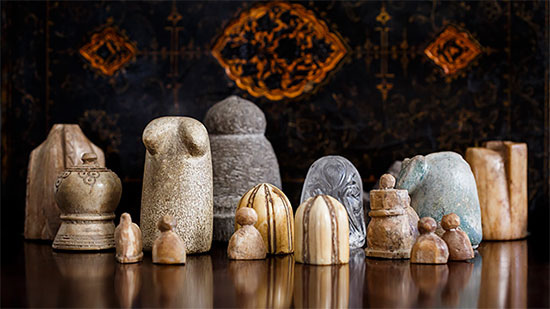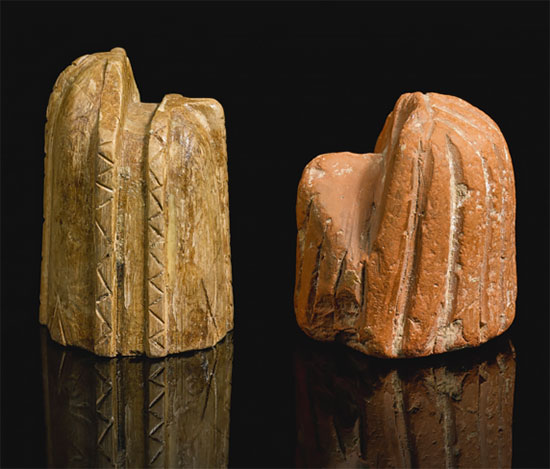All images by Sotheby's
This remarkable private collection of early chess pieces is to go under the hammer next month is part of Sotheby’s Arts of the Islamic World auction in London. The Islamic World auction is not purely about chess, but will contain many extremely rare pieces, all of which come from the private collection of the late GM Lothar Schmid.

This important collection of early chess pieces reveals how the the origins of the game are
rooted in India and the Middle East. Each of these remarkable pieces carries huge significance
in its evolution, including an extremely rare, early and almost complete 10th-century set.
Born in 1928, Lothar Schmid was a German grandmaster whose chess career peaked in the late 60s and early 70s with notable results such as second place in Bamberg in 1968 tied with Tigran Petrosian, the reigning world champion, just behind Paul Keres the winner. In 1970 he won the international tournament in Mar del Plata. Nevertheless, for most chess players familiar with his name, he is best known for his role as the chief arbiter of the famous 1972 world championship match between Bobby Fischer and Boris Spassky in Reykjavik.
Perhaps less well-known to many is his fame and reputation among aficionados as an avid chess collector. He was always picking up items throughout his travels as both a player and arbiter. “He visited book shops and antique shops wherever he could,” said Wolfgang Schmid, one of his three children, to the Financial Times. “He was like a little boy when he got home to show us.”
His interests extended to chess books and paraphernalia, and it was reputed that he owned the largest known private chess library in the world, as well as a spectacular collection of chess art, chess boards and chess pieces from around the globe.
The auction of early chess pieces is just a small part of the chess sets, books and memorabilia that Schmid collected until he passed away in 2013. Among other things, he amassed a 50,000-volume library of chess books, including some of the rarest chess texts dating back to 1497.
Wolfgang said that next month’s Sotheby’s event would probably be the first of several sales, including of his father’s renowned library. “He was a collector,” Wolfgang said. “We are not.”

The Arts of the Islamic World auction contains a large number of fascinating
items that extend far beyond chess, such as this large brass astrolabe, signed
by Diya' al-Dîn Muhammad al-Lahurî, India, dated 1658-59 AD. It is estimated
at least $250 thousand.

Among the rare pieces from the Schmid Collection is this Fatimid rock
crystal chess piece, Egypt, from the 11th century

Six chess and other gaming pieces from Egypt and Persia, 9th-12th century

Three 'King' chess pieces from 9th-12th century Persia and Near East. A similar ivory king chess
piece, of tall form with a small stylised ‘tower’ section, attributed to Nishapur, 9th-12th century,
is in the Metropolitan Museum of Art in New York. At the time that the museum acquired these
pieces in 1940, they formed part of an excavation that had been found in Nishapur, and which
included alabaster pieces.

Two chess pieces, a 'Bishop' and a 'Rook', probably Nishapur, Persia, circa 12th century

Two chess pieces, a 'Bishop' and a 'Knight', probably Nishapur, Persia, circa 12th century. These
present good examples of the bishop and knight forms existing on chess sets in twelfth century
Persia. Chess pieces with a stylised, abstract design are characteristic of Muslim chess pieces,
these forms being copied later on in Europe, or attributed to Muslim craftsmen working on European
commissions. The two small protuberances on the Bishop would have originally been intended as
an elephant's tusks, whereas the Knight, with its stylised animal form, now resembling a mouse,
would most probably have represented a horse.

A large Fatimid rock crystal chess piece from 11th century Egypt

Two large 'King' chess pieces, Persia and Near East, 9th-12th century

These two stone gaming pieces, from 9th-12th century Central or South Asia, are reminiscent of
the ‘stupa’, the emblematic Buddhist architectural form marking the skyline of South Asia. Whereas
early texts refer to stupa shrines being erected over the scattered remains of the Buddha, their
characteristic form has been re-interpreted and adapted on multiple architectural monuments. No
other known examples of this form are known in chess pieces, their attribution being a stylistic one.

Of all the chess items on sale, this is undoubtedly the 'pièce de résistance': A rare Samanid
part chess-set, Nishapur, 10th/11th century or earlier. Whereas individual chess pieces of
this form and from such an early period are known, complete chess sets are not. As highlighted
by Dr. Thomas Thomsen, President for the last twenty years of Chess Collectors International:
"In my forty years' experience, I am not aware of any other chess set from this period".
Initial estimates are at $40 thousand but it could easily fetch three or four times that much.

The Arts of Islamic World auction will take place at Sotheby's on April 20. More information can be found here.



































